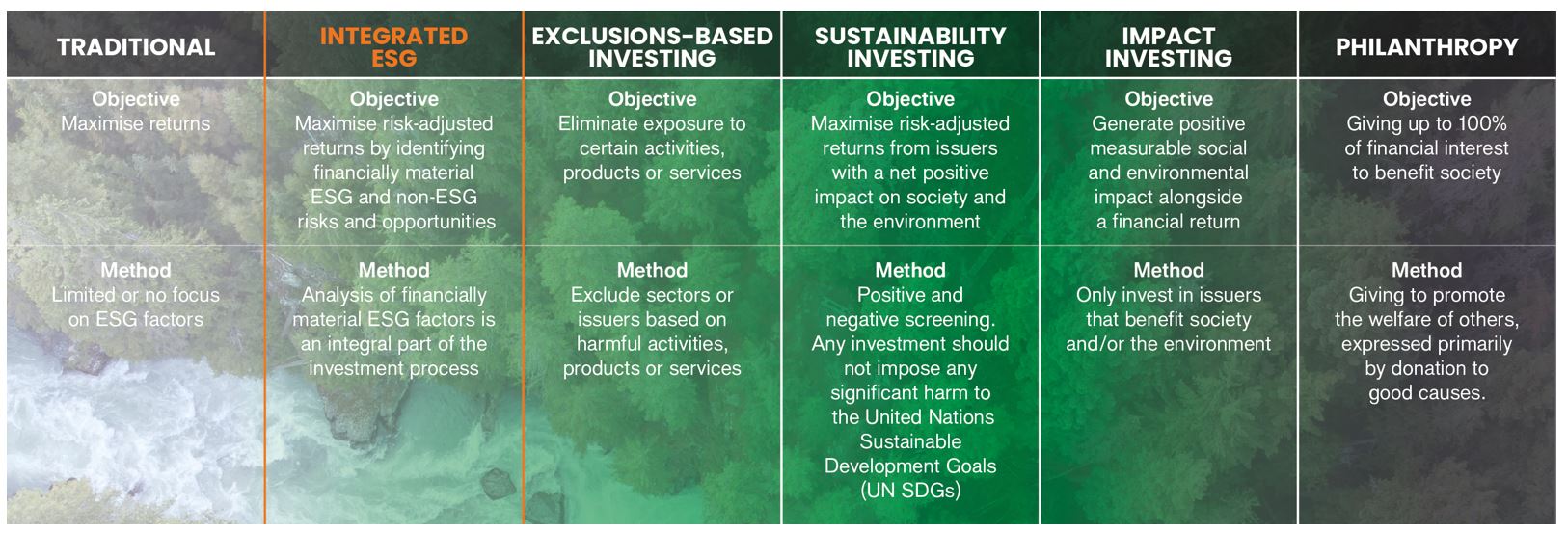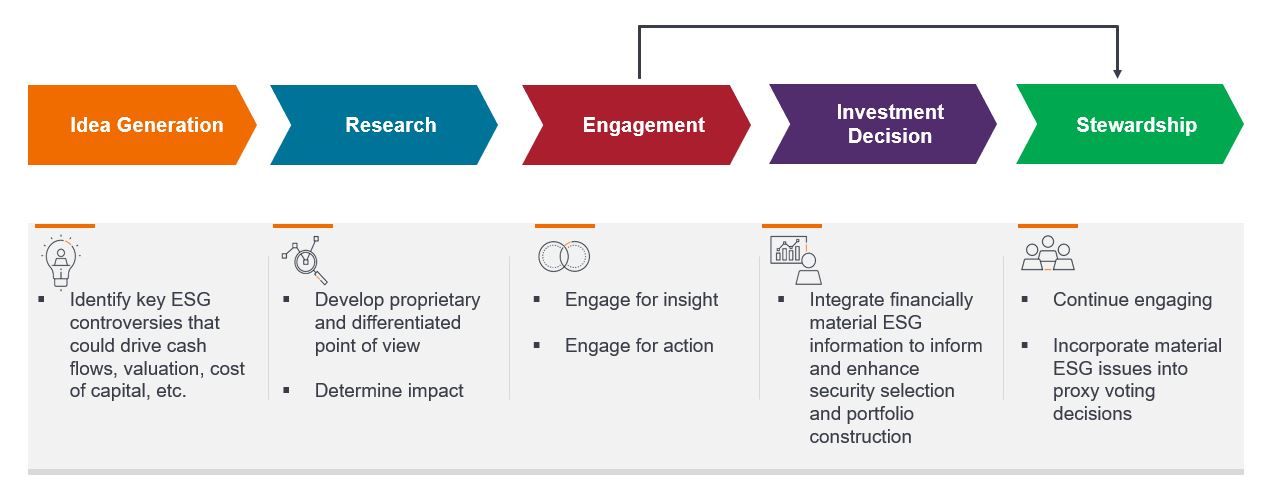What is ESG and why do we care?
Michelle Dunstan, Janus Henderson’s Chief Responsibility Officer, explores ESG considerations and highlights how ESG integration helps Janus Henderson deliver on client goals and aspirations.

6 minute read
Key takeaways:
- A lack of clearly defined industry-wide terms related to ESG has led to confusion about its purpose. Janus Henderson focuses on ESG integration: the analysis and incorporation of financially material ESG issues in the investment process, just like other financially material factors. This incremental lens of risk/return analysis makes us better investors on behalf of our clients.
- ESG considerations are adding to how people think about investing, with a growing recognition of the meaningful financial impact they may have on company performance.
- We believe ESG integration should be thoughtful, practical, research-driven, and forward-looking. Approached in this way it can have a meaningful positive impact on long-term investment returns.
Our ESG integration approach: Thoughtful, practical, research-driven and forward-looking
ESG stands for environmental, social and governance. These three categories are reshaping how people think about investing around the world. This is based on a growing recognition of the financial impact ESG can have on company cash flows, valuations, cost of capital, and ultimately investment returns.
At a glance:
- Environmental criteria examine how a company manages risks and opportunities relating to environmental challenges. Considerations include carbon emissions, waste, impacts and dependencies on deforestation, and biodiversity loss.
- Social criteria focus on how a company treats its key stakeholders, particularly its employees. Considerations include human capital management, diversity, equity and inclusion opportunities, health and productivity of workspaces, and rules around product mis-selling to customers.
- Governance criteria examine how a company is governed, who makes decisions, and who is accountable. Considerations include executive remuneration, tax practices and strategy, and board diversity and structure.
An ‘integrated’ approach to ESG is the consideration of E, S, and G factors that may directly influence the long-term financial success of a company.
Are ESG factors ‘financially material’?
The term ‘materiality’ is used to describe the financial impact that is attributed to specific environmental, social, or governance factors. An ESG issue is material if it affects (or could affect) the future value of a company. Which ESG issues are financially material can vary significantly between companies and industries. For example, a material ESG metric that may influence the future value of an industrial company is how it deals with toxic waste. If the company does not dispose waste in an environmentally sustainable manner, it may be exposed to litigation, fines, loss of reputation, or loss of customers. However, this issue will be largely immaterial for a software company where social issues, such as how it manages cybersecurity concerns, might be more critical to its future success.
At the heart of ESG integration is the simple idea that evaluating and understanding a company from both traditional financial analysis and ESG financial materiality analysis allows for a more complete perspective of a company’s future performance than either alone.
While the focus is often on the management of risks associated with ESG factors, these same factors often create opportunities. Companies that are improving on critical ESG measures or are exposed to ESG-driven growth trends could represent attractive investment opportunities. For instance, a company that is at the forefront of developing a lower-carbon version of its products may be better positioned to gain market share.
Importantly, ESG analysis is not about what a company is doing today, but about the future. Our research focuses on how a company is managing ESG risks and opportunities and the impact on future cash flows or valuation – the same as for traditional financial analysis.
How is ESG integrated in practice?
Strategies that include ESG span a range of approaches which are often used in combination as part of an overall portfolio approach. While there are generally no agreed upon standardised definitions, at Janus Henderson, we see five main approaches, and, in general apply an integrated approach, as we believe this helps us deliver better investment returns for our clients.
Figure 1: ESG investment approaches

For actively-managed portfolios, ESG integration can help investors maximise risk-adjusted returns. Some asset owners want to invest for a purpose beyond just financial outcomes; for these clients asset managers offer a range of ESG-focused strategies – an ESG objective alongside a financial objective. These approaches include sustainable investing and impact investing.
Why is ESG so important?
At Janus Henderson, we believe consideration of financially material factors is vital to long-term risk-adjusted returns over time and is consistent with our fiduciary duty to clients. We believe ESG integration is increasingly important given the scale and extent of disruptive megatrends, such as climate change or the rise of artificial intelligence. Such challenges can represent substantial long-term financial risks and opportunities to investor portfolios.
Our approach to ESG integration has been crafted to be thoughtful, practical, research-driven, and forward-looking. When evaluating a company, we think about its products and services, its behaviour, conduct, supply chain management, and other considerations in running a business. Our ESG analysis considers not only a company’s current ESG practices, but also its strategy and future commitments.
Figure 2: ESG in our investment process

At Janus Henderson, we leverage our differentiated research to drive optimal outcomes for our clients. Research on financially material ESG themes from our central ESG Responsibility Team and investment teams is integral to the generation of actionable investment insights. We share the research and views of our investment teams through articles, videos, and white papers on our website.
Through our engagements, we leverage our access to portfolio companies to conduct research for insight, but also for action, to help these companies create long-term value by encouraging companies to better manage financially material ESG risks and opportunities. Such research is integral to Janus Henderson’s DNA and can help us generate persistent long-term returns over time.
In addition to those investment teams that apply an ESG integrated approach in our portfolios, we recognise that many clients want us to go further and implement specific ESG objectives. For those clients, we have built a suite of ESG-focused strategies that marry an emphasis on sustainable investment with financial considerations.
We care about ESG because we are passionate about fulfilling our fiduciary duty to our clients to help them meet their long-term financial goals. We believe a critical enabler of meeting these goals and client aspirations includes integrating financially material ESG factors into our investment decisions, as we do other financially material factors, and acting as effective stewards of their capital.
Footnote:
Sustainable Development Goals (SDGs): the United Nation’s 17 interlinked Sustainable Development Goals are a call for action by all countries to promote prosperity while protecting the planet. They address global challenges, including poverty, inequality, climate change, environmental degradation, and peace and justice, and are intended to be achieved by 2030.
IMPORTANT INFORMATION
Sustainable or Environmental, Social and Governance (ESG) investing considers factors beyond traditional financial analysis. This may limit available investments and cause performance and exposures to differ from, and potentially be more concentrated in certain areas than the broader market.
These are the views of the author at the time of publication and may differ from the views of other individuals/teams at Janus Henderson Investors. References made to individual securities do not constitute a recommendation to buy, sell or hold any security, investment strategy or market sector, and should not be assumed to be profitable. Janus Henderson Investors, its affiliated advisor, or its employees, may have a position in the securities mentioned.
Past performance does not predict future returns. The value of an investment and the income from it can fall as well as rise and you may not get back the amount originally invested.
The information in this article does not qualify as an investment recommendation.
Marketing Communication.
